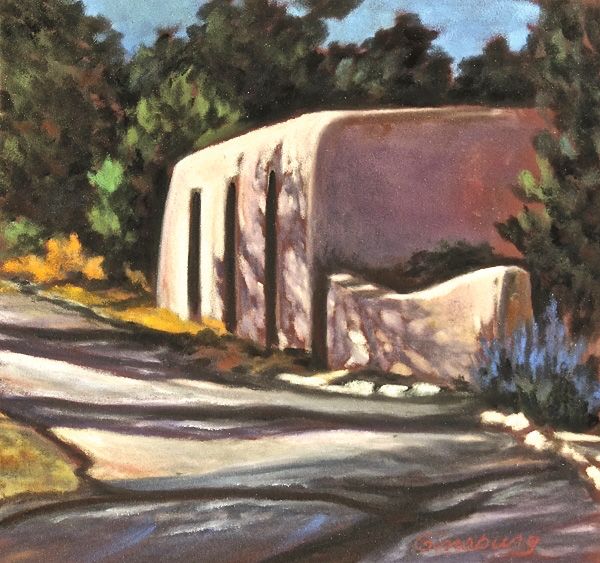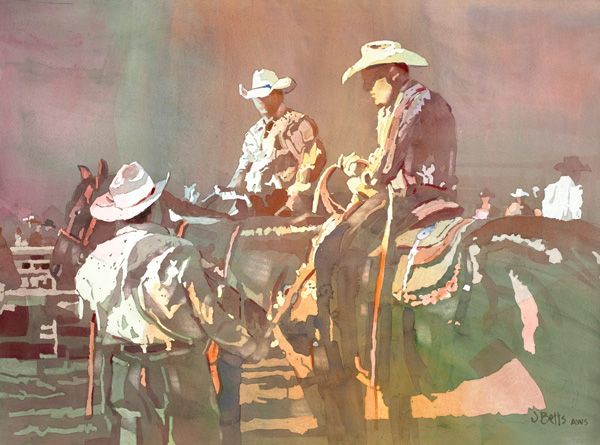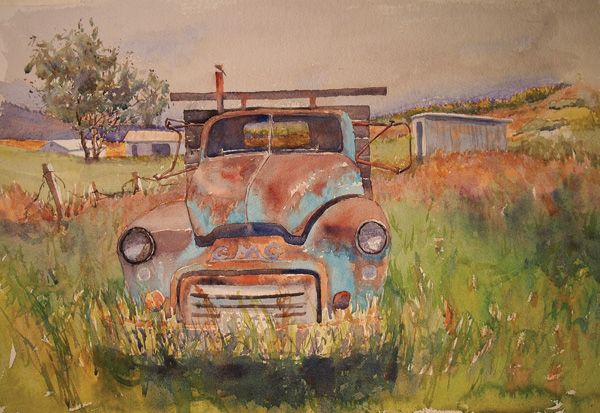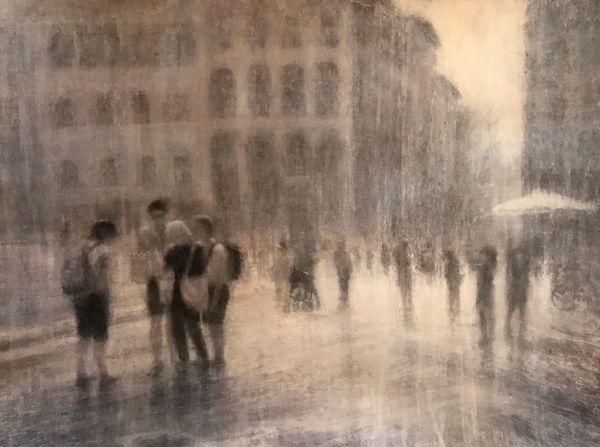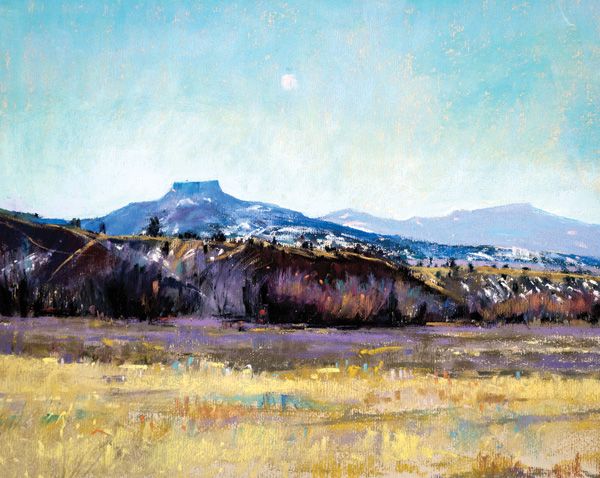Meet 5 artists working in watercolor, pastel, and more
This story was featured in the May 2019 issue of Southwest Art magazine. Get the Southwest Art May 2019 print issue or digital download now–then subscribe to Southwest Art and never miss another story.
CHERI GINSBURG
How would you describe your style? Whether it’s pastel, oil, or pen and ink, my work is often recognized by a quiet sense of tranquil serenity and exquisite colors.
How did you first get interested in art? Early on, I studied interior design; I began my artistic journey painting murals and sculpting in stone and bronze. I entered a national sculpture show and was astonished to have three pieces juried in on my first attempt. Later I set my art aside while raising my children and caring for my parents. But 10 years ago, a cancer diagnosis stopped me in my tracks. I suffered some complications and, while I was hospitalized, I began to escape into a pencil drawing I’d never had time to complete. I promised myself that, if I got through this challenge, I would pursue my art dreams.
Where did you study art? I began to realize that I was consistently drawn to pastels, even though, at the time, I had no idea what they were. I decided to learn from the best and bought myself a nonrefundable ticket to France to take the first of many workshops from top pastel and oil artists.
What have been some of the highlights of your career? I have shown my work nationally and internationally; I’ve been represented by galleries in New Mexico, Pennsylvania, and Nebraska; and today I have my own working studio/gallery at Hot Shops Art Center in Omaha, NE, which is an extraordinary art destination featuring the open studios of over 80 artists.
What galleries represent your work? www.cheriginsburg.com
JUDI BETTS
What inspires you to paint? I’m fascinated with the relationships between colors, shapes, and the spaces between shapes.
How would you describe your style? Creative realism. I’m fascinated with abstract painting, and I like to have abstract shapes in my work. The word “surprise” is very important to me—I want people to see the unexpected in my work.
How did you first get interested in art? As a kid, I never put my crayons away. Even in junior high, I wrapped packages creatively—in fact, I got out of doing the dishes for the month of December because I was helping wrap packages.
Where did you study art? My major at Indiana University was silversmithing and jewelry design. I got my master’s degree from Louisiana State University and then chose watermedia as my focus.
What other artists have influenced your work? Rex Brandt, Barse Miller, Millard Sheets, Milford Zornes, and George Post of the California school, plus Matisse, Sargent, and Homer.
What is your creative process like? Sometimes I start with a value sketch; otherwise I go straight to drawing on watercolor paper. Usually I wet the paper for the first wash, and I preserve the whites. After that I work on the paper without wetting it, applying 10 to 12 layers of paint.
What have been some of the highlights of your career? Being invited to the Art in the Garden festivals at Disney’s Epcot theme park. Being a signature member of the American Watercolor Society and a founding member of Watercolor USA. Having my work in museums. Teaching workshops in 48 states and many countries for 62 years—I can’t believe I get paid to have so much fun!
What galleries represent your work? Baton Rouge Gallery, Baton Rouge, LA.
ROLF LYGREN
What inspires you to paint? I see these daily natural wonders—it could be a tree, river, rock, landscape, or coastline—and I feel that beauty lives somewhere in me. I paint to find, express, and give form to that shared planetary existence.
How would you describe your style? It’s a combination of painterly and impressionistic.
How did you first get interested in art? My grandmother and mother loved art, and they painted in oils. We traveled to Carmel, CA, to view the coast, art galleries, and Fisherman’s Wharf on our winter vacations.
Where did you study art? My first real teacher was Nevin Kempthorne. She inspired me, taught me about painting, and gave me the impulse to be excited about art. I completed a bachelor’s degree in studio painting at the University of California, Santa Cruz. I’ve also attended workshops with some of the most recognized artists around today.
What other artists have influenced your work? Donald Teague, Wayne Thiebaud, Richard Diebenkorn, John Singer Sargent, Winslow Homer, Andrew Wyeth, and many more.
What have been some of the highlights of your career? I’m pleased that I’ve been a part of many group shows all over California and that I have a diverse collector base.
When you’re not creating art, what else do you enjoy doing? Spending time with my family. We love traveling, boating, and cooking together; some of our most fun moments have been in the kitchen. I also love music and play the guitar.
What galleries represent your work? I’m currently looking for gallery representation. I’ve also been juried into the Carmel Art Festival for many years running.
SUSAN HOPE FOGEL
What inspires you to paint? Whether I am painting a landscape or a figure in an environment, it is the quality of light that inspires me to paint.
How would you describe your style? I use the term “deconstructionist” to describe the style, where I destroy rigid boundaries between forms, creating a blend of reality and fantasy.
How did you first get interested in art? My interest started with drawing from the age of 4 and has continued nonstop ever since.
Where did you study art? At the New York Academy of Art, with Harvey Dinnerstein and Ron Sherr at the Art Students League of New York and the National Academy of Design, and with John Phillip Osborne at the Ridgewood Art Institute.
What other artists have influenced your work? I was introduced to a group of watercolor artists working in a Harlem, NY, studio who had studied with Paul Ching-Bor. I was enthralled with their work in the deconstructionist style and began studying with Ching-Bor at the Art Students League in 2015.
What is your creative process like? Developing a watercolor painting is a slow process of layering paint that is splattered, dripped, pulled, or brushed onto the surface. I call it experimental watercolor because each painting can introduce a new technique in the application of paint.
What have been some of the highlights of your career? I’ve had two articles in American Artist magazine. I’ve won awards from the Salmagundi Club, the North East Watercolor Society, and the American Watercolor Society, of which I’m a signature member.
What galleries represent your work? Carrie Haddad Gallery, Hudson, NY; ArtSuite, Piermont, NY; www.susanhopefogelwatercolor.com.
HEIDI A. MARSHALL
What inspires you to paint? The strong pulse of light and beauty. At times, just before sunset, the light unfurls like colorful bolts of silk over the mountains. It takes my breath away.
How would you describe your style? I’m an impressionist. Ralph Waldo Emerson captured my love for plein-air work when he wrote, “Live in the sunshine, swim in the sea, drink in the wild air.” I enjoy being out there, expressing it all.
How did you first get interested in art? My dad, Bill Amenda, was an artist. He painted, sculpted, and was an illustrator for The Detroit News. He’d often let me tag along to watch him do courtroom sketches.
Where did you study art? At Albion College in Michigan. I received a bachelor of fine art degree and later a master’s of fine art in writing from Wayne State University in Detroit.
What other artists have influenced your work? I love Goya, Sorolla, Fechin, Sargent, Klimt, Degas, The Group of Seven, Claudel, and on and on. I’ve studied with Bill Hosner and Albert Handell.
What have been some of the highlights of your career? Last year I received the Paula Ford Memorial Award at the International Association of Pastel Societies’ juried exhibition. Also last year, one of my paintings was accepted into the Pastel Society of America’s exhibition at the National Arts Club. In 2017 I had a solo exhibit at Crooked Tree Arts Center in Petoskey, MI.
What galleries represent your work? Sage Creek Gallery, Santa Fe, NM; Three Pines Gallery, Harbor Springs, MI; Crooked Tree Arts Center, Petoskey, MI; www.heidiamarshall.com.
This story was featured in the May 2019 issue of Southwest Art magazine. Get the Southwest Art May 2019 print issue or digital download now–then subscribe to Southwest Art and never miss another story.
MORE RESOURCES FOR ART COLLECTORS & ENTHUSIASTS
• Subscribe to Southwest Art magazine
• Learn how to paint & how to draw with downloads, books, videos & more from North Light Shop
• Sign up for your Southwest Art email newsletter & download a FREE ebook






